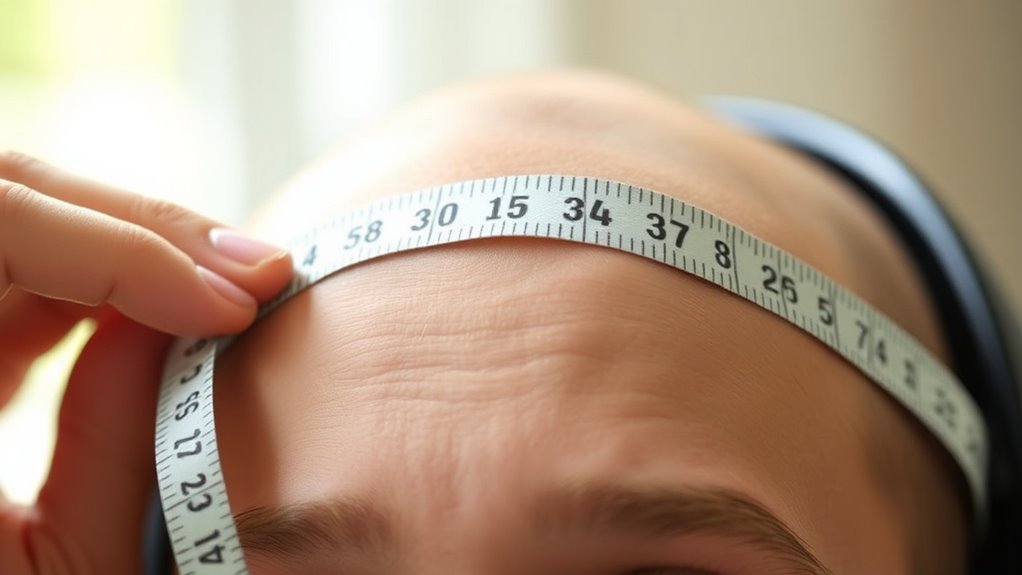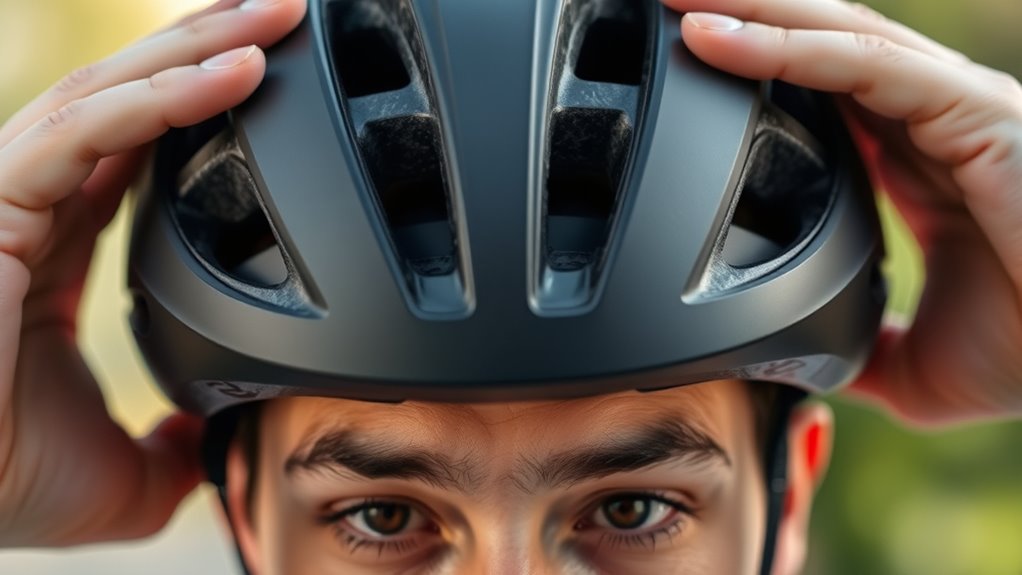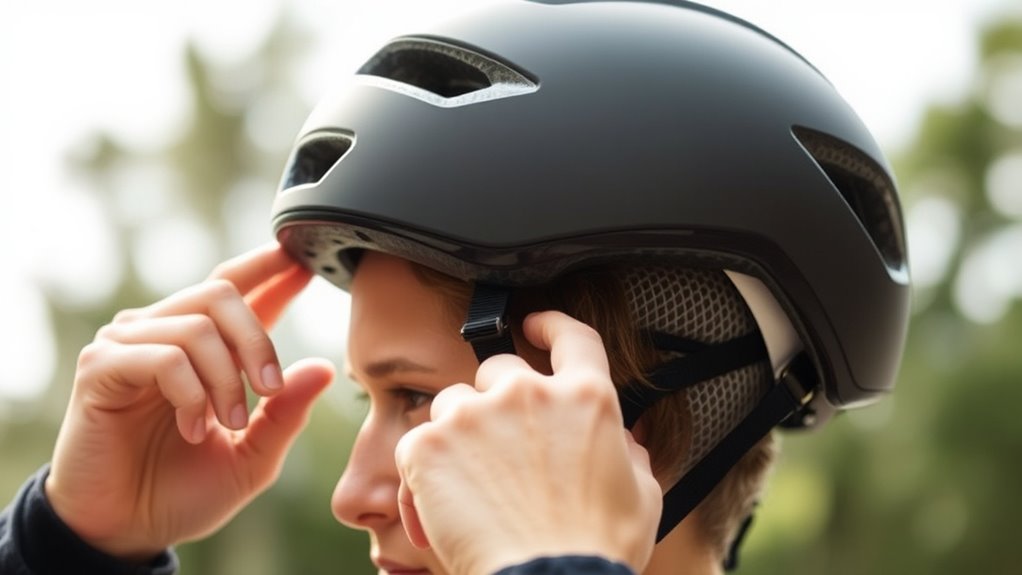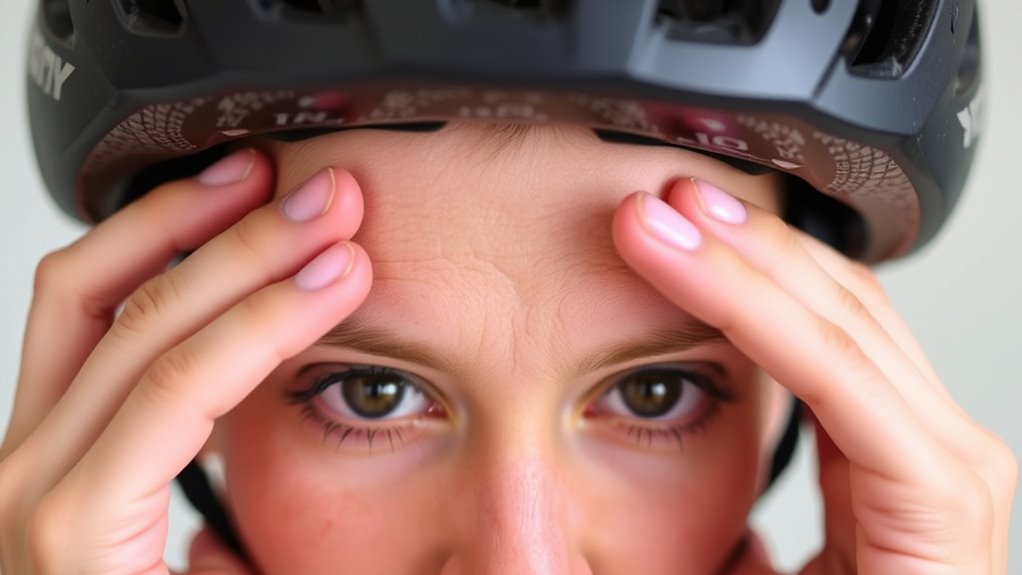To properly fit a bike helmet, measure your head about an inch above your eyebrows with a tape or string, then select a helmet size that matches your measurement. Place the helmet level on your head, just above your eyebrows, and adjust the straps so they form a V below your ears, with only two fingers’ width of space under your chin. Secure the straps snugly and guarantee the helmet doesn’t shift side to side or front to back. For details on perfect positioning and adjustments, keep going.
Key Takeaways
- Measure head circumference about 1 inch above eyebrows using a tape measure or string for an accurate fit.
- Select the helmet size that matches your head measurement according to the brand’s size chart.
- Place the helmet level on your head, just above the eyebrows, ensuring it sits comfortably without being too tight or loose.
- Adjust and tighten the chin strap so it forms a V under the ears and allows two fingers’ width of space under the chin.
- Perform stability checks by moving the helmet side-to-side and front-to-back to ensure a secure and proper fit.
Measuring Your Head for the Correct Fit

Have you measured your head accurately? To find the right helmet size, you need to measure your head carefully. Use a cloth tape measure or a piece of string and a ruler to measure the circumference about one inch above your eyebrows. Make sure the tape measure is snug but not too tight—your helmet should fit comfortably, not painfully tight. Record the measurement in inches or centimeters. It’s important to take multiple measurements around the same area to ensure accuracy and consistency. Once you have your measurement, refer to the helmet size chart provided by the manufacturer. Confirm that your measurement fits within the recommended size range to select the best helmet size for a secure, comfortable fit. Proper fit and comfort are essential for safety and enjoyment while riding. Additionally, understanding proper helmet fitting techniques can help prevent discomfort and ensure maximum protection. Ensuring helmet position on your head is correct can also improve safety and comfort. Remember that a correctly fitted helmet also relies on adjustment and straps to stay securely in place during a ride.
Selecting the Right Helmet Size

To select the right helmet size, start by referring to the brand’s specific size chart and matching your measured head circumference to the recommended range. Use a cloth tape measure or string and ruler to measure about an inch above your eyebrows. Make certain the helmet that fits comfortably sits level and just above your eyebrows without feeling too tight or loose. Take multiple measurements to confirm consistency and guarantee a snug, secure fit. Remember, a helmet that fits properly can make all the difference in safety and comfort. Use this chart to guide your choice:
| Size | Head Circumference |
|---|---|
| XS | Less than 20 inches |
| S | 20-21.75 inches |
| M | 21.75-23.25 inches |
| L | 23.25-24.75 inches |
Make certain to choose the right size bike helmet for maximum protection.
Placing and Positioning the Helmet Properly

Positioning your helmet correctly is essential for effective protection and comfort. First, place the helmet on your head, making sure it sits level just above your eyebrows for good forehead coverage. Adjust the rear fit system so the helmet fits snugly without causing discomfort or pressure points. Before finalizing, secure the straps by unlocking strap dividers and lining up the chin strap beneath your earlobes. Tighten the chin strap until it lies flat against your chin, with enough room for two fingers’ width for comfort. To guarantee proper placement, perform side-to-side and front-to-back movement tests—your helmet should stay securely in place without shifting. This proper positioning guarantees a good fit and maximum protection while riding. Incorporating vintage textiles and accessories can also add a charming touch to your gear setup. Ensuring the helmet is properly fitted also involves checking the adjustability features, which can help customize the fit for different head shapes and sizes. Additionally, choosing a helmet with certification standards ensures it meets safety requirements for optimal protection. Regularly inspecting your helmet for wear and damage is important to maintain its protective capabilities over time. Moreover, understanding the importance of proper fit can significantly reduce the risk of injury during a fall.
Adjusting and Securing the Helmet Straps

Ensuring your helmet stays securely in place depends on properly adjusting and fastening the straps. First, thread the chinstrap buckle securely until it clicks, then tighten it so it sits snugly beneath your earlobes. Use a tape measure if needed to check the strap length, ensuring the straps form a V shape that meets just below your ears. Pull the straps to eliminate slack, so the helmet doesn’t shift side to side or front to back during riding. Tuck any excess chinstrap material into the keeper to prevent flapping or discomfort. Different helmet models may have slight adjustments, but the goal remains the same: secure fit with only two fingers’ width of space under your chin. Proper strap adjustment keeps your helmet stable and effective in case of impact. Additionally, understanding the importance of helmet safety standards can help ensure you select a helmet that provides adequate protection. Regularly checking the helmet fit is also essential to maintain safety and comfort during rides, as a properly fitted helmet can reduce injury severity in an accident. Remember, a correctly fitted helmet not only enhances safety but also improves confidence while cycling.
Final Fit Checks and Managing Excess Strap

Once you’ve secured and tightened the straps, it’s important to verify that the helmet fits properly. To find the right bike helmet, make sure it sits level on your head, covering your forehead just above the eyebrows, without tilting forward or back. Check that the chin strap is snug—only two fingers should fit between the strap and your chin—and tighten if needed. Manage any excess strap by tucking it into the keeper to prevent flapping or snagging. When cutting the strap, leave at least 1 inch past the buckle and melt the end to prevent fraying. Proper helmet fit is essential for maximum protection during a crash. Ensuring the helmet fits correctly also supports safety standards, which are designed to protect you effectively. Regularly inspecting your helmet and replacing it after impacts helps maintain optimal safety compliance and protection. Finally, test the fit by moving the helmet side-to-side and front-to-back; it should stay snug and not shift, ensuring you’ve found the right fit for safe riding.
Frequently Asked Questions
How Is a Bike Helmet Supposed to Fit?
A bike helmet should sit level on your head, covering your forehead just above your eyebrows. It must fit snugly, with the interior adjusted so it doesn’t move side-to-side or front-to-back. Your straps should form a V under each ear and be tight enough so only two fingers fit underneath. It should feel comfortable, secure, and not shift more than an inch when you move it manually.
What Is the 2 2 2 Rule When Fitting a Helmet on Your Head?
Think of the 2-2-2 rule as your helmet’s personal blueprint for safety. It means your helmet should sit level, covering your forehead just above your eyebrows like a protective crown. The straps should form a “V” under your ears, snug enough for two fingers to fit — not too tight, not too loose. This guarantees your helmet stays secure, providing maximum protection in every ride.
How Do You Know When Your Helmet Is Fitted Correctly?
You’ll know your helmet fits correctly if it sits level on your head, covering your forehead just above your eyebrows, and doesn’t shift more than an inch side-to-side or front-to-back when gently pushed. The straps should form a snug “V” under your ears, with the buckle secured and only two fingers fitting between your chin and strap. When you open your mouth wide, it should press lightly against your head, indicating a proper fit.
What Is the Rule for Helmet Fitting?
Think of your helmet as a crown sitting perfectly on your head. It should sit level, covering your forehead just above your eyebrows, without tilting. It needs to be snug but comfortable, with only two fingers’ width under the chin strap. When you gently push, it shouldn’t shift more than an inch side-to-side or front-to-back. The straps should form a neat ‘V’ under your ears and click securely, ensuring top protection.
Conclusion
Now that your helmet fits like a tailored hat, you’re ready to hit the road with confidence. Think of your helmet as a trusty shield, snug and secure, ready to protect you through every twist and turn. When it sits just right, you’ll feel like a rider with armor made for adventure. So, tighten, adjust, and trust that your helmet’s got your back—your safety is the ultimate ride.









